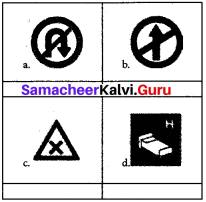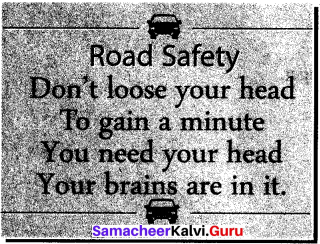You can Download Samacheer Kalvi 6th Social Science Book Solutions Guide Pdf, Tamilnadu State Board help you to revise the complete Syllabus and score more marks in your examinations.
Tamilnadu Samacheer Kalvi 6th Social Science Civics Solutions Term 3 Chapter 3 Road Safety
Samacheer Kalvi 6th Social Science Road Safety Textual Evaluation
I. Answer the following :
Question 1.
Prepare the slogans for road safety.
Answer:
- Alert today – Alive tomorrow
- Normal speed meets every need.
- You Can’t get home unless you are safe.
- Be alert to be safe and secure.
- Be alert while driving on the road
- Be a driver not clever while driving.
![]()
Question 2.
Identify the following signs.

Answer:
a. No U-Turn
b. No Entry
c. Cross Road
d. Hospital
Question 3.
Discuss the statistics of 2017 accidents data.
Answer:
- 2017 saw a 3% decline in road accident deaths.
- Punjab, West Bengal, and Gujarat have shown a decline.
- Bihar, Uttarpradesh, Odhisha, and Madhya Pradesh have reported more deaths.
- The data also shows that a maximum decline was reported from Tamil Nadu in Comparison to 2016.
- Percentage-wise the Steepest decline was in Punjab at 15.7%
Question 4.
Debate: Is Wearing a helmet necessary?
Answer:
- It is important for motorcyclists to understand the risks of riding without a helmet.
- Riders who do not wear helmets are at risk of suffering traumatic brain injury if they are in an accident.
- Without protection, the head is vulnerable to a traumatic impact in an accident even when travelling at low speeds.
- Wearing a helmet is absolutely necessary for riders and pillion riders.
Question 5.
Draw posters related to road safety.
Answer:

Samacheer Kalvi 6th Social Science Road Safety Additional Questions
I. Choose the correct answer:
Question 1.
Mandatory road signs are_________generally in shape.
(a) Circular
(b) Oval
(c) Square
(d) Hexagonal
Answer:
(a) Circular
![]()
Question 2.
The pedestrian crossing was instituted in Britain in_________
(a) 1930
(b) 1932
(e) 1934
(d) 1936
Answer:
(c) 1934
Question 3.
Children above_________ years of age should occupy the back seat.
(a) 8
(b) 12
(c) 10
(d) 14
Answer:
(b) 12
Question 4.
The Zebra crossing with black and white stripes was developed after
(a) Cold war
(b) Civil war
(c) First World war
(d) Second World war
Answer:
(d) Second World war
Question 5.
Red rings or circles give_________ instructions
(a) Positive
(b) Negative
(c) Caution
(d) None of the above
Answer:
(b) Negative
II. Fill in the blanks:
- Cautionary road signs are generally in_________ shape.
- Informatory road signs are generally in_________ shape.
- We should wait until_________ a signal appears before proceeding.
- Amber means_________
- Traffic signs are there to_________traffic.
- Answer:
- Triangular
- Rectangular
- Caution
- green
- Regulate
III. Answer the following questions :
Question 1.
Explain the three types of traffic signs.
Answer:
- Mandatory road signs are the ones that give orders regarding do’s and don’ts and are to be followed strictly. They are generally circular in shape.
- Cautionary road signs are the ones that were in the road rules regarding the road situation ahead. These signs are generally in a triangular shape.
- Informatory road signs are the ones that give information regarding directions, destinations etc. Informatory signs are generally rectangular in shape.
![]()
Question 2.
What do the three colours Red, Amber, and Green signify?
Answer:
- Red means stop – wait behind the stop line.
- Amber means CAUTION.
- Green means Go-Proceed ahead ensuring that the way is clear.
Question 3.
Mention the languages of the road.
Answer:
- Road signs, markings, traffic signals and other traffic devices are there to guide the road users and hence the languages of the road.
- Traffic signals are there to regulate traffic, warn about hazards and to guide the road user.
Question 4.
How should children use pavements?
Answer:
Children should be taught to use the pavements. When walking on the road,
- Walk on any side of the road if there are food paths.
- On roads without food, path walks on your extreme right side facing the oncoming traffic.
- Use Zebra crossing, foot over bridge, and subways to cross the roads.
- Children below 8 years of age should cross the road with the help of elders.
![]()
Question 5.
What should not be done by children while crossing the road?
Answer:
- Do not cross the road hastily by running.
- Do not cross the road in front of or in between parked vehicles.
- Do not try to cross the road from blind comers, turnings where you are not visible to the vehicle drivers.
- Do not jump over the railings to cross the road.